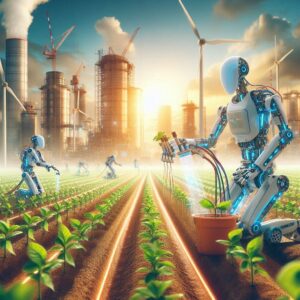The agricultural industry is witnessing a transformative revolution, thanks to the integration of robotics. These advanced machines are enhancing efficiency, precision, and sustainability in farming practices. In this article, we’ll explore how robotics is transforming agriculture for the better and the various applications that are revolutionizing the field.
Enhancing Efficiency in Agriculture
- Automating Labor-Intensive Tasks: Robotics is automating labor-intensive tasks such as planting, weeding, and harvesting. This automation reduces the reliance on manual labor, increases productivity, and ensures timely completion of tasks.
- 24/7 Operations: Robots can operate around the clock without the need for breaks, ensuring continuous productivity. This capability is particularly beneficial during critical periods such as planting and harvesting seasons.
- Precision Agriculture: With the help of advanced sensors and GPS technology, robots can perform tasks with high precision. This precision reduces wastage of resources such as seeds, fertilizers, and water, leading to cost savings and improved crop yields.
- Data-Driven Decision Making: Robots equipped with AI and machine learning can collect and analyze data from the field. This data-driven approach enables farmers to make informed decisions regarding crop management, pest control, and irrigation, resulting in optimized farming practices.
Revolutionizing Farming Practices
- Autonomous Tractors and Machinery: Autonomous tractors and machinery are revolutionizing traditional farming methods. These robots can plow, plant, and harvest crops with minimal human intervention, enhancing efficiency and accuracy in the process.
- Robotic Weed Control: Weed control is a significant challenge in agriculture. Robotic weeders use computer vision and AI to identify and remove weeds selectively, reducing the need for chemical herbicides and promoting sustainable farming practices.
- Drones for Monitoring and Surveillance: Drones equipped with high-resolution cameras and sensors are being used for crop monitoring and surveillance. They provide real-time data on crop health, growth patterns, and pest infestations, allowing farmers to take timely actions.
- Harvesting Robots: Harvesting delicate crops such as fruits and vegetables requires precision and care. Harvesting robots are designed to handle these tasks efficiently, reducing damage to the produce and ensuring high-quality harvests.
The Future of Robotics in Agriculture
The future of robotics in agriculture is promising, with several advancements on the horizon:
- AI-Driven Robotics: The integration of AI and machine learning with robotics will drive further innovations. AI-driven robots can learn from data, adapt to new tasks, and optimize their performance, making them invaluable assets in agriculture.
- Collaborative Robots (Cobots): Collaborative robots, or cobots, are designed to work alongside human workers. In agriculture, cobots can assist with tasks such as planting, harvesting, and sorting, enhancing productivity and safety.
- Sustainable Farming Practices: Robotics will play a crucial role in promoting sustainable farming practices. Robots can optimize resource utilization, reduce waste, and minimize the environmental impact of farming activities.
- Robotic Integration in Urban Agriculture: As urban agriculture gains popularity, robots will be essential in optimizing space and resources. They can perform tasks such as vertical farming, hydroponics, and aquaponics, making urban farming more efficient and viable.
Conclusion
Robotics is transforming agriculture by enhancing efficiency, precision, and sustainability in farming practices. From automating labor-intensive tasks to promoting sustainable farming, robots are revolutionizing the agricultural industry. As technology continues to advance, the future of robotics in agriculture holds immense promise, paving the way for smarter and more efficient farming practices.

